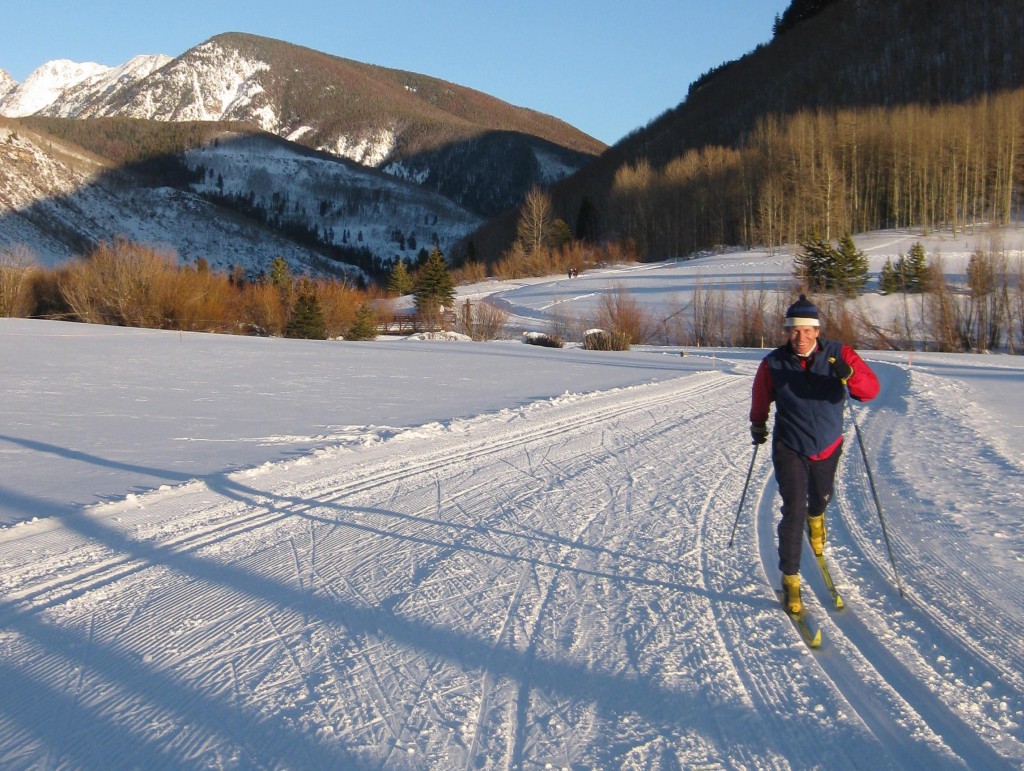Winter Fitness Alternative for Walkers and Runners
Photo Credit: Cecily, via Flickr Creative Commons
Snow can make any landscape look like a postcard, and you don’t have to fly to Aspen to get a skier’s high. Both snowshoeing and cross-country skiing are excellent alternatives for walkers and runners when snow interferes with your regular routine. They both offer all-body and aerobic workouts with many benefits.
Snowshoes and cross-country skis are lightweight and inexpensive compared to downhill skis
Inexpensive and Convenient
Most communities that enjoy regular snow have ski and snowshoe trails. Once you know the sport well, you can take your own equipment to any nearby golf course or park—both snowshoes and cross-country skis are lightweight and inexpensive compared to downhill skis.
In many regions, you can drive to a cross-country ski and snowshoe center, which is often located on a farm. Also check near downhill ski resorts or state parks. A full-service center will offer lessons, groomed trails and equipment, all for much less than you would spend at a downhill resort.
Nature Enhances Your Health
Many snowshoe or cross-country trails are hiking trails that will bring you up close to trees and frozen ponds and streams. Once you’re experienced enough to take on curvy trails, you’ll see new sights at each turn. Being outdoors in a natural setting enhances the mental lift you get from exercising, according to a study by Stanford researchers published in the June, 2015 issue of Landscape and Urban Planning.
A Full-Body Workout
Another sport will let you work your muscles in a different way. Snowshoeing is easier to learn, but both are gentle on the knees, while strengthening your legs, and help to improve your balance. Use your poles, and you’ll get a full-body workout, increasing your calorie burn per hour and elevating your heart rate by an extra 5-20 beats per minute.
They Can Be Tailored to Your Experience and Fitness Level
Start with flat trails and take on more hills and curves gradually. Your chances of injury are much lower than if you take up downhill skiing for the first time or try to run or jog on an icy surface.
You Don’t Need Bulky Clothing
The right clothing will keep you warm, and you might be surprised at how little you need (See “Winter Fitness: It’s Not About the Cold; It’s About the Clothes.”). Water transfers heat from the body much more quickly than air, so sweating will make you colder.
Follow these common sense principles to stay safe and comfortable:
Get a lesson. Both sports are relatively easy to learn but do require that you move differently than you would on a city street. A little training will give you a chance to enjoy the sport. Downhill skiers alert: Cross-country skiing will require that your body unlearn some of its habits, so you might have a harder time on your first day than someone who has never skied before.
Get properly fitted. As a beginner, try different styles of boots when you rent and see what you prefer before you invest. Every time you go out, take the time to be sure your equipment is adjusted to your needs.
Start slow! Don’t blaze your own path on a golf course until you really know what you’re doing. Even if you’re an ace hiker, don’t assume you can spend as much time on snow-shoes or skis as you would hiking in the summer. You’ll be using your muscles differently.
Maintain your temperature. On cold days, always bring a buddy. You might warm up with a cup of hot chocolate before you go out on the trail. Cover up your head, fingers, and toes, to start.
You’ll need a synthetic layer close to the skin to draw sweat away, then a layer of warm fleece or wool. Put a waterproof windbreaker on last. Stay away from cotton, even in your socks, because it can get wet.
If you have asthma, it might be triggered in cold weather, if you’re breathing dry air. Wear a face mask, scarf, or balaclava to cover your mouth: your exhale will moisten the air you breathe in.
While you’re moving, notice if you’re getting hot. Take off your hat first. A large percentage of body heat is lost through your scalp
Bring water and energy boosts. Drink before you’re thirsty: Dehydration from sweat can cause fatigue. See a sampling of Ornish-friendly snack in our sample menus.
Keep track of the time and nightfall. Unlike downhill ski centers, most snow-shoe and cross-country centers don’t light the trails at night.






